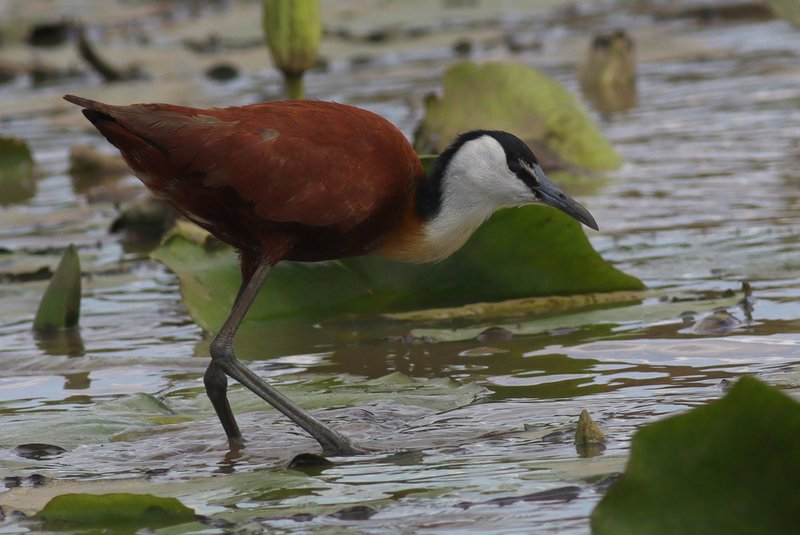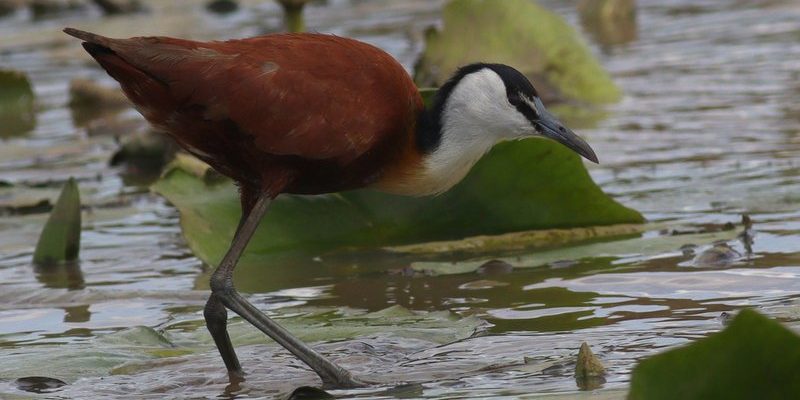
The African Jacana is truly a unique bird found in the wetlands of sub-Saharan Africa. Imagine a creature that seems to walk on water! With its long legs and large feet, this bird can often be seen strutting across floating plants in search of food. It’s not just their appearance that’s fascinating; the African Jacana has a plethora of intriguing behaviors and habits that make it stand out in the avian world.
When you first catch a glimpse of this bird, you might mistake it for a tropical bird out of a storybook. With its striking colors and graceful movements, the African Jacana is hard to forget. These birds are quite social, typically seen moving in small groups, and they thrive in their lush, watery habitats. Let’s dive deeper into the world of the African Jacana, exploring its lifestyle, habitat, and what makes it such an extraordinary creature.
Physical Characteristics
The physical attributes of the African Jacana are as remarkable as its behavior. This bird is medium-sized, generally measuring around 28 to 30 cm in length. Its most distinctive features are its long toes and slender legs, which enable it to walk effortlessly on floating vegetation. It’s almost as if each step is a carefully choreographed dance as it navigates through its marshy environment.
You’ll notice its bold plumage, with a striking combination of chestnut brown and blue-grey colors. The male and female African Jacana are quite similar in appearance, but males tend to have a slightly more vibrant coloration, especially during the breeding season. Their underparts are white, which contrasts beautifully against their darker feathers. This combination helps them blend in with the lily pads and reeds they call home.
Adaptations
The African Jacana has developed several fascinating adaptations to thrive in its wetland habitats. Its long toes are not just for show; they allow the bird to distribute its weight across the surface of floating plants, preventing it from sinking. This adaptation is crucial for foraging, as it can navigate through dense mats of water lilies and other vegetation with ease.
Additionally, their legs are not only long but also quite strong, providing quick bursts of speed when necessary. This agility helps them escape from potential predators, such as snakes and larger birds. Their long legs also enable them to reach deep into the water to catch small fish and insects, adding a diverse range to their diet.
Habitat and Distribution
You’ll typically find the African Jacana in freshwater wetlands, swamps, and marshes, primarily throughout sub-Saharan Africa. They favor areas with abundant floating vegetation, such as water lilies and papyrus. These habitats not only provide food and shelter but also serve as nesting sites. The African Jacana is often seen in pairs or small groups, moving gracefully across these serene landscapes.
During the rainy season, their range can expand significantly as the wetlands flood, creating new territories. This adaptability allows them to thrive in diverse environments, from shallow lakes to rice paddies. Their ability to move between various wetland ecosystems is critical for their survival and reproductive success.
Nesting Behavior
The nesting habits of the African Jacana are particularly interesting. Instead of building traditional nests, these birds lay their eggs directly on floating vegetation. The male is primarily responsible for nesting duties, meticulously choosing a safe spot to lay their eggs. Each nest usually contains around three to four eggs, which are camouflaged to blend in with their surroundings.
Once the eggs are laid, the male takes on the role of protector, guarding the nest from potential threats. Interestingly, the female often mates with multiple males, and each male may tend to his own nest. This social structure is quite fascinating and sets the African Jacana apart from many other bird species.
Diet and Feeding Habits
The diet of the African Jacana is quite varied, consisting mainly of insects, small fish, and plant material. They use their long toes to wade through shallow waters, picking at the surface for food. Their diet is essential for their survival, as they need to consume a range of nutrients to maintain their energy levels.
During foraging, you might spot them probing the mud or the water’s surface, searching for aquatic invertebrates. They’re also known to eat seeds and leaves, especially during dry seasons when animal food becomes scarce. Their adaptability in diet plays a crucial role in their ability to survive in changing environments.
Social Behavior
The social structure of the African Jacana is as intriguing as their physical characteristics. These birds are often observed in small groups, which aids in foraging and protection from predators. Communication among group members is frequent; they use a series of calls and body language to stay connected. You might even see them engage in playful behavior, such as chasing each other across the water’s surface!
During the breeding season, males can exhibit some fascinating behaviors to attract females. This can include elaborate displays, such as raising their wings and puffing out their chests. As mentioned earlier, females may mate with several males, leading to a unique form of social structure where males become doting fathers, all while competing for the female’s attention!
Conservation Status
Currently, the conservation status of the African Jacana is considered to be Least Concern according to the IUCN Red List. Fortunately, their adaptability to different wetland habitats allows them to flourish in various environments. However, threats such as habitat loss due to drainage of wetlands and pollution pose significant risks.
Conservation efforts are essential to ensure the continued survival of these birds. Protecting their natural habitats and promoting sustainable practices in agriculture and land use can help maintain the delicate balance of their ecosystems. Wetland conservation is not just beneficial for the African Jacana, but for countless other species that share these unique environments.
Interesting Facts
| Common Name: | African Jacana |
| Scientific Name: | Actophilornis africanus |
| Habitat: | Freshwater wetlands, swamps, and marshes |
| Diet: | Insects, small fish, and plant material |
| Size: | 28 to 30 cm in length |
| Lifespan: | 5 to 10 years in the wild |
The African Jacana is more than just a pretty face in the wetlands of Africa. Its remarkable adaptations, fascinating social behaviors, and unique nesting habits make it a truly captivating bird to observe. Understanding these creatures helps us appreciate the importance of conserving their natural habitats, ensuring future generations can enjoy these remarkable sights. So, the next time you find yourself near a wetland, keep an eye out for the graceful African Jacana—it’s a sight you won’t forget!
FAQ
What is the African Jacana’s primary habitat?
The African Jacana primarily inhabits freshwater wetlands, swamps, and marshes. These environments are rich in floating vegetation, which provides both food and nesting sites for the birds. They thrive in areas where their unique adaptations, like their long toes, allow them to walk on water and forage effectively.
How do African Jacanas care for their young?
In African Jacanas, the males take on the responsibility of caring for the young. After the eggs are laid, the male will guard the nest and, once the chicks hatch, he continues to protect and lead them to safe foraging grounds. This dedicated parental care is quite typical in their social structure.
Are African Jacanas social birds?
Yes, African Jacanas are quite social and are often seen moving in small groups. This social behavior helps them with foraging and provides protection from predators. Their interactions often include playful behavior, showcasing their lively nature as they navigate their wetland homes.
What do African Jacanas eat?
African Jacanas have a diverse diet that primarily consists of insects, small fish, and plant material. They are adept foragers, using their long toes to sift through water and mud to find food. This adaptability allows them to thrive even in changing environmental conditions.
Do African Jacanas migrate?
African Jacanas are generally resident birds, meaning they do not migrate over long distances. However, their movements may vary seasonally, especially during the rainy season when their habitats expand. They adapt to new areas as wetlands flood, but they typically remain within their preferred sub-Saharan regions.
What threats do African Jacanas face?
While currently listed as Least Concern, African Jacanas face threats primarily from habitat loss due to wetland drainage, agriculture, and pollution. Conservation efforts focused on protecting their habitats are crucial in ensuring their survival and the health of their ecosystems.
How do African Jacanas attract mates?
During the breeding season, male African Jacanas engage in elaborate displays to attract females. This can include raising their wings and puffing out their chests. Their social structure allows for multiple mating partners, which adds a unique twist to their reproductive behavior.
Can African Jacanas swim?
While African Jacanas are not strong swimmers, they can paddle gently through water if needed. However, they primarily rely on their long legs and toes to walk on floating vegetation rather than swimming. This adaptation allows them to navigate their environment efficiently.
Why are African Jacanas important to their ecosystem?
African Jacanas play a crucial role in their wetlands by helping to control insect populations and contributing to the overall health of their ecosystems. As foragers, they help maintain the balance of aquatic life, which benefits both plants and other animal species sharing their habitat.
How long do African Jacanas live?
In the wild, African Jacanas typically have a lifespan of about 5 to 10 years. Like many wild birds, their longevity can be influenced by environmental conditions, predation, and food availability. Protecting their habitats is essential for their continued survival and well-being.
Are African Jacanas monogamous?
African Jacanas are not strictly monogamous. Females often mate with multiple males during the breeding season. This social structure contributes to their unique breeding behavior, where the male typically takes on the primary role in nesting and caring for the young.
What colors are African Jacanas?
African Jacanas display a striking combination of chestnut brown and blue-grey plumage, which makes them visually appealing. Their underparts are white, creating a beautiful contrast. These colors help them blend into their wetland environments, offering some camouflage against predators.

